Exploring the Role of Boundary Spanning towards Service Ecosystem Expansion: A Case of Careem in Pakistan
Abstract
:1. Introduction
Problem Statement
- To analyze the role of actors, practices, and resources in Careem to understand the business model.
- To evaluate the role of Careem in the society through the expansion of service eco-system for a better understanding of resource distribution and to encourage small and medium investors to promote a sharing culture.
- To determine the ways of cross-business collaborations among multiple stakeholders by initializing the service ecosystem in developing countries for resource management.
2. Literature Review
2.1. Framing Sharing Economy in the Context of Sustainability
2.1.1. Role of Sharing Economy in Developing Countries
2.1.2. Growth of Transportation Network Companies (TNCs)
2.1.3. Careem a Case of TNC in Pakistan
“Careem is a brand that aims to simplify people’s lives by revolutionizing the transportation industry. A brand that strives to inspire everyone, it interacts with and supports every single person who dares to believe. A brand that exists to drive our region towards something better (Mudassir Sheikha)”.[26]
“We are all about simplifying people’s lives and moving our region towards better living”.[26]
Careem has succeeded to overcome its rival company Uber in the region (Middle East and Pakistan) and became the brand of people’s choice. In 2018, Careem got 30 million (plus) registered users from 120 (plus) cities, 15 (plus) countries and 1 million (plus) drivers. Overall, the estimated amount of Careem funding was 770 million dollars (2019).[26]
2.2. Theoretical Foundation to Explain Sharing Economy
2.2.1. Service Science and Service Systems
2.2.2. Sphere of Service Ecosystem
2.2.3. Resource Integration
2.3. Boundary Spanning for Expansion of Sharing Economy
2.3.1. Nature of Boundary Spanning
2.3.2. The Significance of Boundaries
2.3.3. Notion of Boundary Object
2.3.4. Role of Boundary Spanner
2.4. Theoretical Framework
3. Research Questions
4. Research Methodology
4.1. Research Design
4.2. Method of Data Collection
4.2.1. Interviews
- The operation manager is responsible to initiate any strategy or suggestions regarding collaborations or new services for the betterment of the company.
- The public relation officer is the backbone of Careem and responsible for collecting and understanding the needs/ demands from all stakeholders.
- The strategy planning officer is responsible for observing market trends, finding feasible and appropriate solutions against any prevailing issues.
- Local Investors are the people who provide loans or cars to potential drivers of Careem and who run a business in partnerships.
- The JS Bank collaborates with Careem and provides loans with easy installments to the drivers that enable them to buy a car.
- Rent-A-Car is a small size business where two or more people collaborate and make a joint company. They gather money, buy a few cars and then hire drivers as employees in order to offer on-demand car services with Careem.
- Rozee.pk is Pakistan’s first online platform for e-recruitment. In 2017, Rozee.pk started its collaboration with Careem. It supports Careem to find good team members and staff (drivers). Rozee.pk plays the role of a mediator between potential drivers and investors.
- Pakwheels.com is an online portal for buying and selling second-hand cars. Moreover, the portal offers extra services like car inspections for buyers and sellers. In 2017, Careem started a collaboration with Pakwheels to ensure the safety of customers by hiring drivers whose cars have an inspection report.
- Jubilee Insurance collaborates with Careem to provide cheap and easy insurance policies to Careem drivers and also arranges awareness seminars for their safety.
- Regulatory authorities ensure the safety on the road by enforcing the rules and regulations and cross-verification of personal documents of a driver to be hired by Careem.
4.2.2. Web Survey
4.3. Method of Data Analysis
- Firstly, the audio data were transcribed, and the interview transcripts were translated from the native language (Urdu) into English;
- Secondly, the transcripts were read several times in order to highlight the notable words, lines, sentence, paragraph, actions, and processes of the interviewees. It helped to develop a clear image of the points of discussion.;
- Thirdly, labeling and categorization were done for the most relevant words, actions, and processes.
- Fourthly, to find associated concepts and relationships, the labels and categories were connected to make a reference;
- Lastly, this study resulted in developing a theory based on the connections and the categorization that has been made;
- In order to keep the privacy, the names of the interviewees have been anonymized.
5. Research Findings
5.1. Service System
A service network that connects institution, people, organizations and community directly or indirectly with the focus on competitiveness with other service systems that are external and independent.
Business Model of Careem in the Context of Service System
The essential fact of Careem is that the entire service transaction is observed and fostered by the regulatory authority. It includes the local police and the traffic police. The local police check the criminal record of a person and provides a certification of his or her clean status […] However, the traffic police ensures the validity of a driving license. Then the potential person can be hired by Careem. Without certification, it is impossible to be employed by Careem.(Careem Management)
Careem has many internal investors and global partners, who support the managerial body to grow and expand the Careem business […] currently, we have a partnership with Rakuten, Telenor, JS Bank, and General Motors.(Careem Management)
Our main focus is to provide job opportunities to unemployed people, […] and also to expand the coverage of passengers as much as possible by observing the local needs.(Careem Management)
We are collaborating with some of the independent companies (i.e., insurance, e-recruitment, and car inspection companies) to enhance the ride service […] we establish contacts among different stakeholders to work together.(Careem Management)
5.2. Service Ecosystem
A service ecosystem is a dynamic system of resource integration that explains service exchange and interaction between different stakeholders.
Development of Service Ecosystem in Careem
Careem is providing not only affordable and quality transportation services but also playing a leadership role for the country’s development.(Careem Management)
Careem is just an App with a great vision for the society. But to implement the vision, Careem does not have enough resources […] therefore, to expand their business, the role of investors and companies cannot be ignored. The real target of Careem is to explore the possibility of mutual cooperation for creating employment opportunities for youth.(Careem Management)
Our job is to enforce safety in the region, by checking the criminal record of drivers and local parties registered with Careem.(Local Police)
5.3. Product/Service Development of Careem through Resource Integration
We are trying to combine the scale of multiple resources to facilitate the lives of more people in the region in additional ways than just mobility […] Our mission is to help and realize the regional potential by joining hands with local allies.(Careem Management)
5.3.1. A Case of Women Driver
Our mission is to give women equal rights as men to generate a healthy income from the utilization of service opportunities and chances provided by Careem.(Careem Management)
I am not that much educated to work in a good company and to earn a healthy income […] But after joining Careem, I earn far better than before, and I can raise my family with good financial support.(Woman Driver)
5.3.2. A Case of Drivers without Car
Facilitation of Drivers without Car (Middle Class)
We are trying to expand our driver’s network. And to achieve this goal, we offer awareness seminars to develop an entrepreneurial mindset among individuals […] it will help them to earn a good income as well as social status.(Careem Management)
Recently, we have initiated a collaboration with Careem to attract trustworthy customers […] Our main role is to sponsor awareness seminars organized by Careem and to provide car loans and leasing on the bases of strong reference offered by Careem.(Bank)
Facilitation of Drivers without Car (Lower Class)
We have found a group of people who are interested to be a captain. But they do not own a car and they have no information regarding investors and banks […] for those people, we organize awareness seminars with the help of sponsors and investors to come-up and work together for Careem.(Careem Management)
My business is mainly to provide cars on an hourly/daily basis. After knowing about the Careem business, I am delighted to provide my cars on a quarterly/half-yearly basis […] Now, I am able to get a proper amount of money every month.(Rent-A-Car)
I invest mostly in the real estate business and the stock market. In the real estate business, I have to make big investments. I make a profit after four to six months on an occasional basis. As the economy is unstable in Pakistan, the stock market either turns into profit or loss […] after attending awareness seminars conducted by Careem, I am eager to work for Careem to make a stable source of income per month.(Local Investor)
We provide an online platform for job seekers and job providers […] recently, we made a collaboration with Careem to give our professional expertise for uneducated people to create a good CV and find a suitable employer for them.(Rozee.pk)
5.3.3. A Case of Authenticity of Drivers with Car
We are responsible for regulating the traffic by enforcing the traffic/road laws and issuance of driving license […] we are liable to conduct road safety seminars for the drivers.(Traffic Police)
Pak wheels is the no.1 online automobile portal in Pakistan. We are known because of our in-detail car inspection and authentic car certification […] in 2017, we started working with Careem. And it is an exciting experience to collaborate with Careem to extend Pakistan’s first and only car inspection service. We are responsible to ensure the good condition of cars registered with Careem. Without our certification, no car can be registered with Careem.
Our vision of assisting people is to overcome uncertainty. We strive to be the best by providing values to the customers in terms of introducing road safety seminars and the importance of car insurance policies […] Being the private sector market leader, we have developed a special policy for Careem drivers to secure their own lives as well as the passengers under an affordable circumstance.(Jubilee Insurance)
5.3.4. Prototype of Resource Integration in Careem
6. Conceptual Framework and Its Implications
- Dealing between Careem and drivers or passengers (app matching).
- The path between drivers and third parties (business matching).
- Interaction between the third parties and passengers (business matching).
6.1. Initiative for Women Empowerment
6.2. Initiative for Drivers without Car
6.3. Initiative for the Authenticity of a Driver
7. Discussion & Conclusions
7.1. Learning Climate
7.2. Cross Business Collaboration
7.3. Social Awareness
7.4. Concluding Remarks
- Careem arranges awareness seminars to give awareness to the stakeholders to mitigate the problem they incurred;
- Careem has expanded its service network and provides many job opportunities to resolve the issue of unemployment;
- Careem succeeded to introduce the match making of resource seeker with the resource holder. And it leads to alleviate the poverty issues in Pakistan;
- Careem supports people in finding investors. Recognizing cultural barriers and finding solutions for local markets are two of the biggest strengths of Careem.
7.5. Research Significance
7.6. Future Research
Author Contributions
Funding
Conflicts of Interest
References
- Botsman, R. The Case for Collaborative Consumption. 2010. Available online: https://www.ted.com/talks/rachel_botsman_the_case_for_collaborative_consumption/transcript (accessed on 28 June 2019).
- Matofska, B. What We Know About the Global Sharing Economy. Available online: https://crowdsourcingweek.com/session/what-we-know-about-the-global-sharing-economy/ (accessed on 12 March 2015).
- Dalberg. Digital Sharing for Global Growth. Sharing Resources, Building Economies. Available online: https://static1.squarespace.com/static/562a4f98e4b0762a208bee14/t/56b0fe0d746fb9caf5c3acaa/1454439955550/DSEReport_Final_2.2.16.pdf (accessed on 2 July 2016).
- Retamal, M.; Dominish, E. The Sharing Economy in Developing Countries. Available online: https://learn.tearfund.org/~/media/files/tilz/circular_economy/2017-tearfund-the-sharing-economy-in-developing-countries-en.pdf?la=en (accessed on 25 April 2017).
- European Parliament. The Cost of Non-Europe in the Sharing Economy. Available online: http://www.europarl.europa.eu/thinktank/de/document.html?reference=EPRS_STU%282016%29558777 (accessed on 3 July 2016).
- Ikkala, T.; Lampinen, A. Monetizing Network Hospitality: Hospitality and Sociability in the Context of Airbnb. In Proceedings of the 18th ACM Conference on Computer Supported Cooperative Work & Social Computing, Vancouver, BC, Canada, 14–18 March 2015; pp. 1033–1044. [Google Scholar]
- Böcker, L.; Meelen, T. Sharing for people, planet or profit? Analysing motivations for intended sharing economy participation. Environ. Innov. Soc. Transit. 2017, 23, 28–39. [Google Scholar] [CrossRef] [Green Version]
- Hamari, J.; Sjöklint, M.; Ukkonen, A. The Sharing Economy: Why People Participate in Collaborative Consumption. J. Assoc. Inf. Sci. Technol. 2016, 67, 2047–2059. [Google Scholar] [CrossRef]
- Botsman, R.; Rogers, R. What’s Mine is Yours: The Rise of Collaborative Consumption; Harper Business: New York, NY, USA, 2011. [Google Scholar]
- Martin, C.J.; Upham, P.; Budd, L. Commercial orientation in grassroots social innovation: Insights from the sharing economy. Ecol. Econ. 2015, 118, 240–251. [Google Scholar] [CrossRef]
- Liu, Y.; Yang, Y. Empirical examination of users’ adoption of the sharing economy in China using an expanded technology acceptance model. Sustainability 2018, 10, 1262. [Google Scholar] [CrossRef]
- Nadler, S. The Sharing Economy: What is it and Where is it Going? Bachelor’s Thesis, MIT Sloan School of Management, Cambridge, MA, USA, 2014. [Google Scholar]
- Brighenti, B. Opinion of the European Committee of the Regions—The Local and Regional Dimension of the Sharing Economy. Off. J. Eur. Union 2016, 51, 28–33. [Google Scholar]
- Heinrichs, H. Sharing economy: A potential new pathway to sustainability. GAIA-Ecol. Perspect. Sci. Soc. 2013, 22, 228–231. [Google Scholar] [CrossRef]
- Frenken, K.; Schor, J. Environmental Innovation and Societal Transitions Putting the Sharing Economy into Perspective; Elsevier B.V.: Amsterdam, The Netherlands, 2017. [Google Scholar]
- Yaraghi, N.; Ravi, S. The Current and Future State of the Sharing Economy. Available online: https://papers.ssrn.com/sol3/papers.cfm?abstract_id=3041207 (accessed on 9 November 2017).
- Retamal, M. Product-service systems in Southeast Asia: Business practices and factors influencing environmental sustainability. J. Clean. Prod. 2017, 143, 894–903. [Google Scholar] [CrossRef]
- Shaheen, S.; Chan, N.; Rayle, L. Ridesourcing’s Impact and Role in Urban Transportation. 2017. Available online: http://www.accessmagazine.org/spring-2017/ridesourcings-impact-and-role-in-urban-transportation/ (accessed on 7 July 2019).
- CPUC. California Public Utilities Commission. 2019. Available online: https://www.cpuc.ca.gov/ (accessed on 6 July 2019).
- Clewlow, R.; Mishra, G. Disruptive Transportation: The Adoption, Utilization, and Impacts of Ride-Hailing in the United States October; Institute of Transportation Studies: Berkeley, CA, USA, 2017. [Google Scholar]
- SFCTA. TNCs Today. A Profile of San Francisco Transportation Network Company Activity. Available online: http://www.sfbayite.org/wp-content/uploads/2018/05/11%20SFCTA%20tncs_today_ite.pdf (accessed on 26 June 2019).
- Rayle, L.; Dai, D.; Chan, N.; Cervero, R.; Shaheen, S. Just a better taxi? A survey-based comparison of taxis, transit, and ridesourcing services in San Francisco. Transp. Policy 2016, 45, 168–178. [Google Scholar] [CrossRef] [Green Version]
- Metcalf, G.; Warburg, J. A Policy Agenda for the Sharing Economy. 2012. Available online: https://www.spur.org/publications/urbanist-article/2012-10-09/policy-agenda-sharing-economy (accessed on 1 July 2019).
- Silver, N.; Fischer-Baum, R. Public Transit Should Be Uber’s New Best Friend. 2015. Available online: https://fivethirtyeight.com/features/public-transit-should-be-ubers-new-best-friend/ (accessed on 2 July 2019).
- Erhardt, G.D.; Roy, S.; Cooper, D.; Sana, B.; Chen, M.; Castiglione, J. Do transportation network companies decrease or increase congestion? Sci. Adv. 2019, 5, eaau2670. [Google Scholar] [CrossRef] [Green Version]
- Careem. Our mission. To Simplify and Improve the Lives of People, and Build an Awesome Organisation that Inspires. 2019. Available online: https://www.careem.com/en-ae (accessed on 5 July 2019).
- Vargo, S.L.; Lusch, R.F. Evolving to a new dominant logic for marketing. J. Mark. 2004, 68, 1–17. [Google Scholar] [CrossRef]
- Vargo, S.L.; Lusch, R.F. Service-dominant logic: Continuing the evolution. J. Acad. Mark. Sci. 2008, 36, 1–10. [Google Scholar] [CrossRef]
- Maglio, P.P.; Spohrer, J. Fundamentals of service science. J. Acad. Mark. Sci. 2008, 36, 18–20. [Google Scholar] [CrossRef]
- Vargo, S.L.; Maglio, P.P.; Akaka, M. On value and value co-creation: A service systems and service logic perspective. Eur. Manag. J. 2008, 26, 145–152. [Google Scholar] [CrossRef]
- Polese, F.; Russo, G.; Carrubbo, L. Service Logic, Value Co-Creation and Networks: Three Dimensions Fostering Inter-Organisational Relationships: Competitiveness in the Boating Industry. In Proceedings of the 12th QMOD and Toulon-Verona’ Conference, Verona, Italy, 27–29 August 2009. [Google Scholar]
- Iansiti, M.; Levien, R. Strategy as Ecology. Harv. Bus. Rev. 2004, 82, 1–10. [Google Scholar]
- Iansiti, M.; Levien, R. The Keystone Advantage: What the New Dynamics of Business Ecosystem Mean for Strategy, Innovation, and Sustainability; Harvard Business School Press: Boston, MA, USA, 2004. [Google Scholar]
- Moore, J.F. Predators and Prey: A New Ecology of Competition. Harv. Bus. Rev. 1993, 71, 75–86. [Google Scholar] [PubMed]
- Moore, J.F. The Death of Competition: Leadership and Strategy in the Age of Business Ecosystem; John Wiley & Sons Ltd.: Hoboken, NJ, USA, 1996. [Google Scholar]
- Lusch, R.F.; Vargo, S.L. Service Dominant Logic. Premises. Perspectives. Possibilities; Cambridge University Press: New York, NY, USA, 2014. [Google Scholar]
- Kaartemo, V.; Akaka, M.A.; Vargo, S.L. A Service-Ecosystem Perspective on Value Creation: Implications for International Business Acknowledgment. In Value Creation in International Business; Palgrave Macmillan: Cham, Switzerland, 2016; pp. 131–149. [Google Scholar]
- Vargo, S.L.; Akaka, M.A. Value Cocreation and Service Systems (Re)Formation: A Service Ecosystems View. Serv. Sci. 2012, 4, 207–217. [Google Scholar] [CrossRef]
- Vargo, S.L.; Wieland, H.; Akaka, M.A. Innovation through institutionalization: A service ecosystems perspective. Ind. Mark. Manag. 2015, 44, 63–72. [Google Scholar] [CrossRef]
- Dopfer, K.; Foster, J.; Potts, J. Micro-meso-macro. J. Evol. Econ. 2004, 14, 263–279. [Google Scholar] [CrossRef]
- Prahalad, C.K.; Ramaswamy, V. Co-creation experiences: The next practice in value creation. J. Interact. Mark. 2004, 18, 5–14. [Google Scholar] [CrossRef] [Green Version]
- Kleinaltenkamp, M.; Brodie, R.J.; Frow, P.; Hughes, T.; Peters, L.D.; Woratschek, H. Resource integration. Mark. Theor. 2012, 12, 201–205. [Google Scholar] [CrossRef] [Green Version]
- Löbler, H. Service-dominant networks. J. Serv. Manag. 2013, 24, 420–434. [Google Scholar] [CrossRef]
- Hislop, D.; Bosua, R.; Helms, R. Knowledge Management in Organizations, 4th ed.; Oxford University Press: Oxford, UK, 2018. [Google Scholar]
- Hwang, E.H.; Singh, P.V.; Argote, L. Knowledge Sharing in Online Communities: Learning to Cross Geographic and Hierarchical Boundaries. Organ. Sci. 2015, 26, 1593–1611. [Google Scholar] [CrossRef]
- Tallman, S.; Phene, A. Leveraging Knowledge Across Geographic Boundaries. Organ. Sci. 2007, 18, 252–260. [Google Scholar] [CrossRef]
- Harryson, S.J.; Dudkowski, R.; Stern, A. Transformation networks in innovation alliances—The development of Volvo C70. J. Manag. Stud. 2008, 45, 745–773. [Google Scholar] [CrossRef]
- Betz, S.; Oberweis, A.; Stephan, R. Knowledge transfer in offshore outsourcing software development projects: An analysis of the challenges and solutions from German clients. Expert Syst. 2012, 31, 282–297. [Google Scholar] [CrossRef]
- Kotlarsky, J.; Scarbrough, H.; Oshri, I. Coordinating Expertise Across Knowledge Boundaries in Offshore-Outsourcing Projects: The Role of Codification. MIS Q. 2014, 38, 607–627. [Google Scholar] [CrossRef]
- Carlile, P.R. A Pragmatic View of Knowledge and Boundaries: Boundary Objects in New Product Development. Organ. Sci. 2002, 13, 442–455. [Google Scholar] [CrossRef] [Green Version]
- Carlile, P.R. Transferring, Translating, and Transforming: An Integrative Framework for Managing Knowledge Across Boundaries. Organ. Sci. 2004, 15, 555–568. [Google Scholar] [CrossRef] [Green Version]
- Williams, P.; Paul, W. The Competent Boundary Spanner. Public Adm. 2002, 80, 103–124. [Google Scholar] [CrossRef]
- Corbin, J.M.; Strauss, A. Basics of Qualitative Research: Techniques and Procedures for Developing Grounded Theory, 4th ed.; Sage: Los Angeles, CA, USA, 2015. [Google Scholar]
- Bryman, A.; Bell, E. Business Research Methods; Oxford University Press: Oxford, UK, 2015. [Google Scholar]
- Uber. Get in the Driver’s Seat and Get Paid. 2019. Available online: https://www.uber.com/ch/en/ (accessed on 8 July 2019).
- Cab, M.R. Welcome to Metro Radio Cab. 2019. Available online: http://metrocab.com.pk (accessed on 4 July 2019).
- Eisenhardt, K.M. Building Theories from Case Study Research. Acad. Manag. Rev. 1989, 14, 532–550. [Google Scholar] [CrossRef]
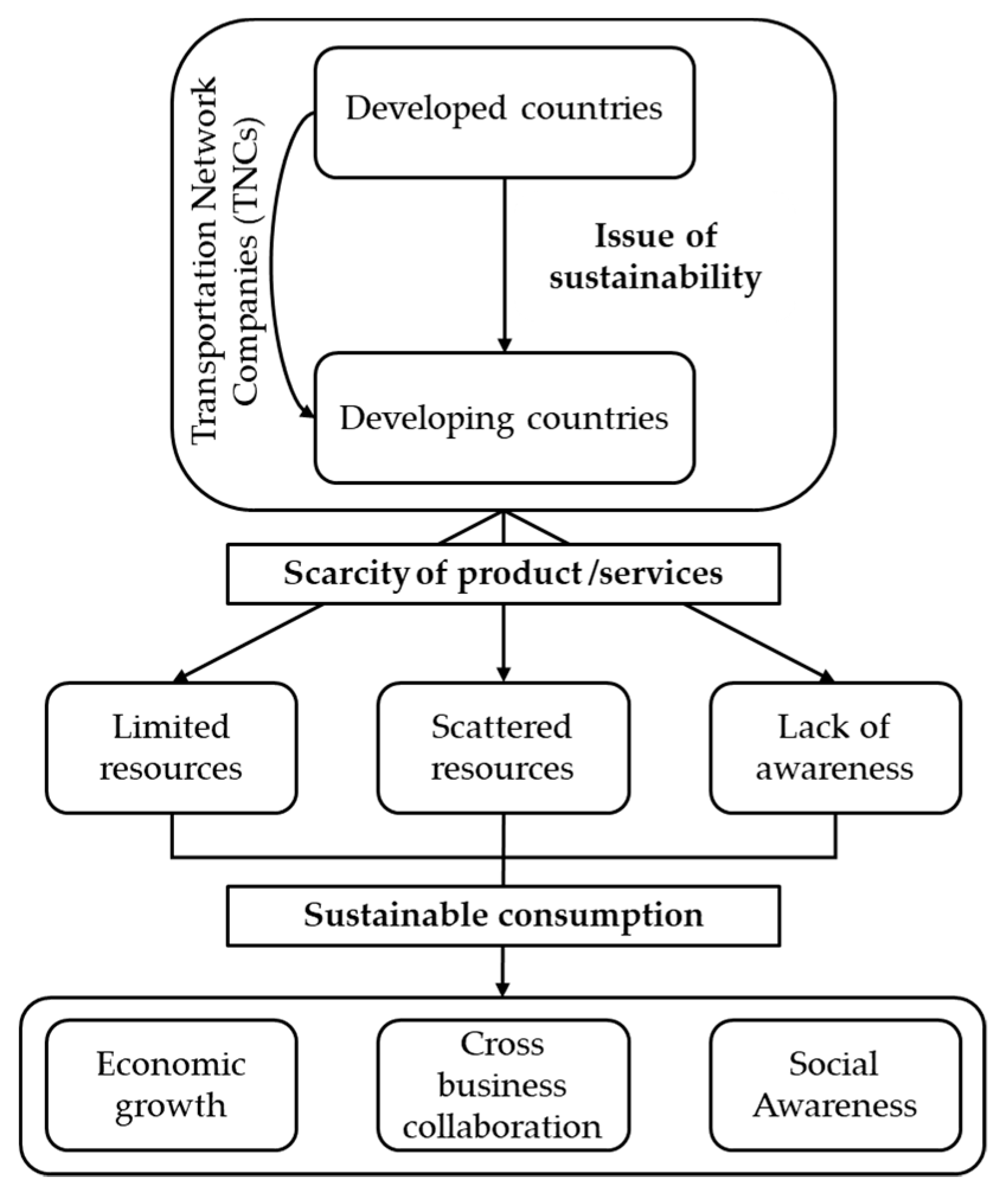
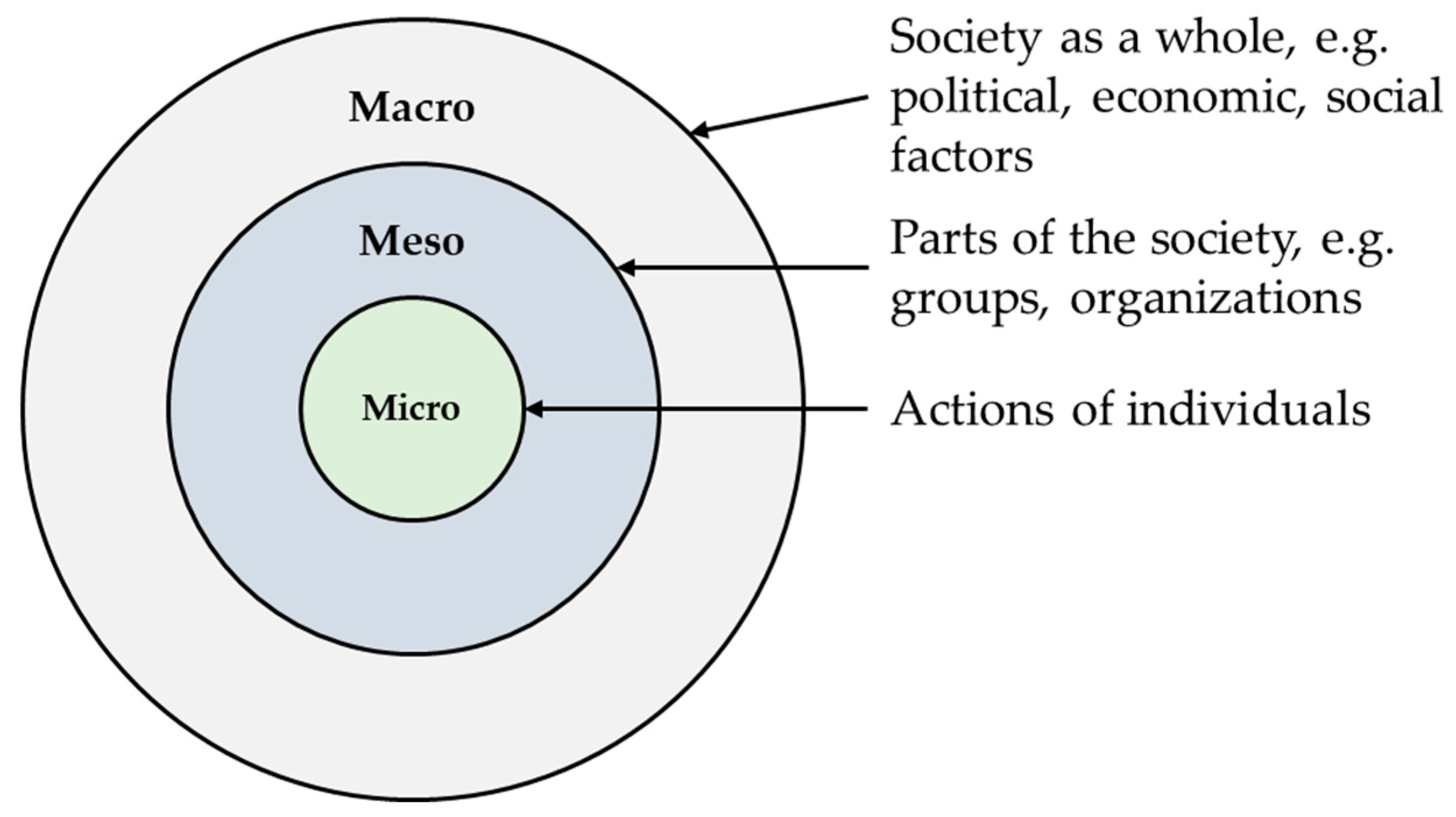

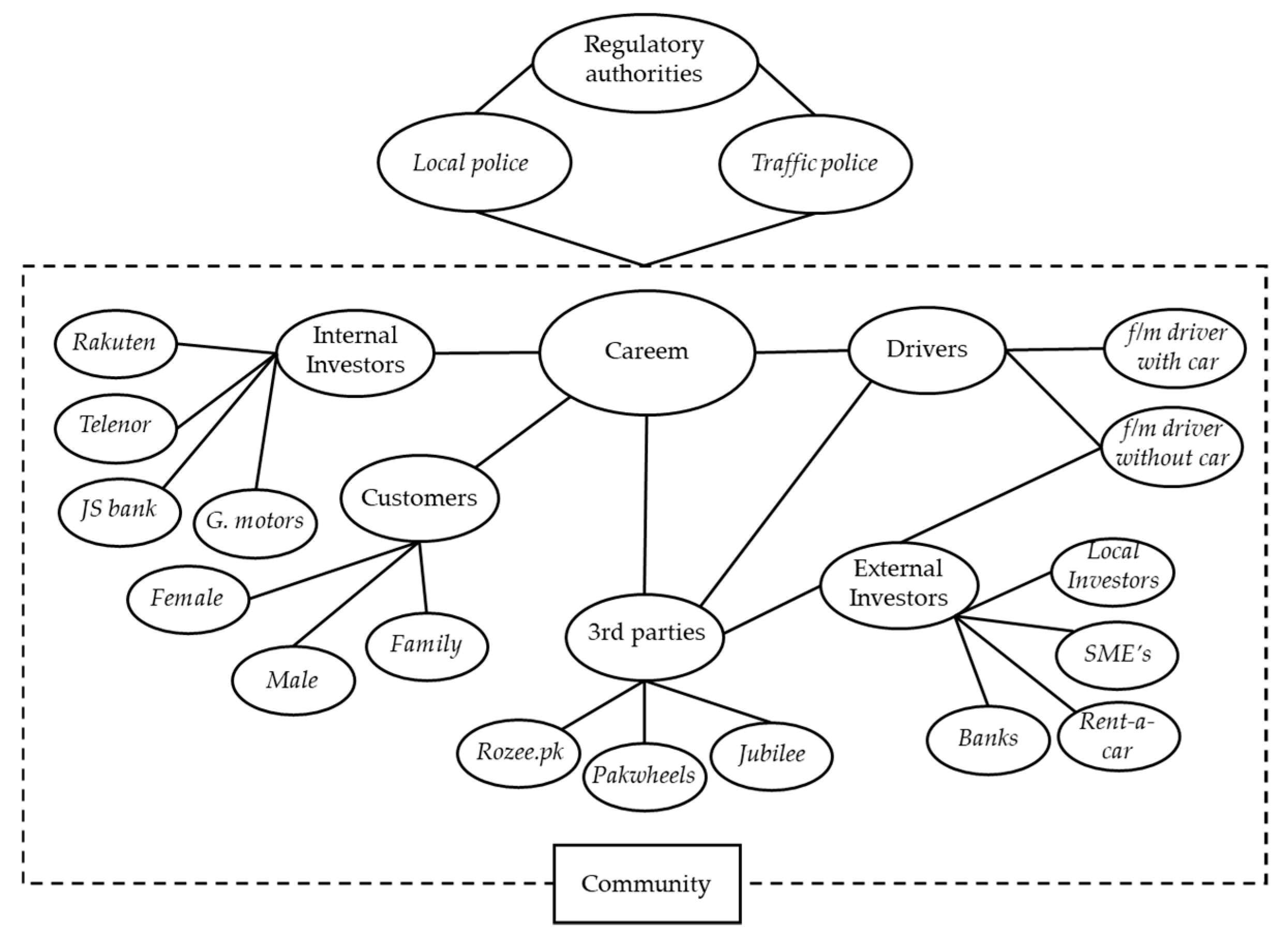
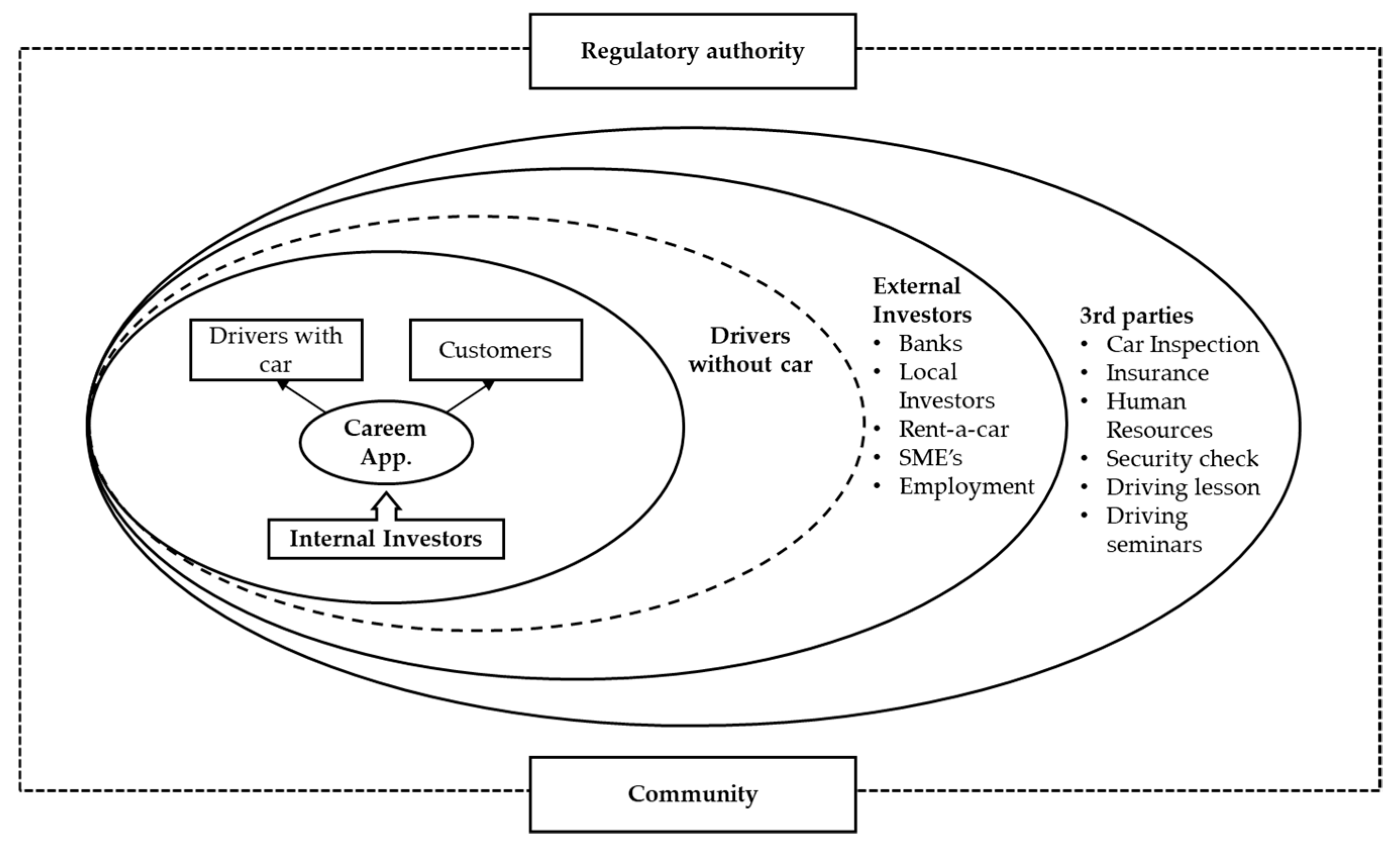
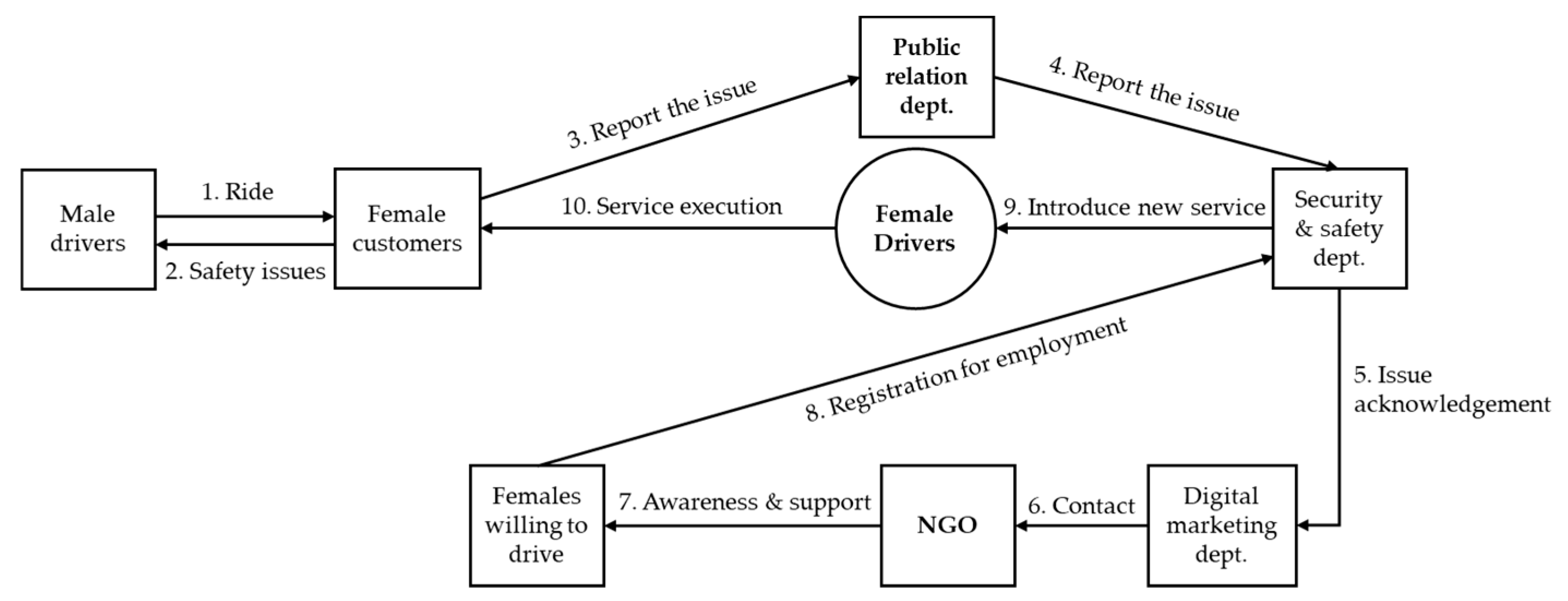
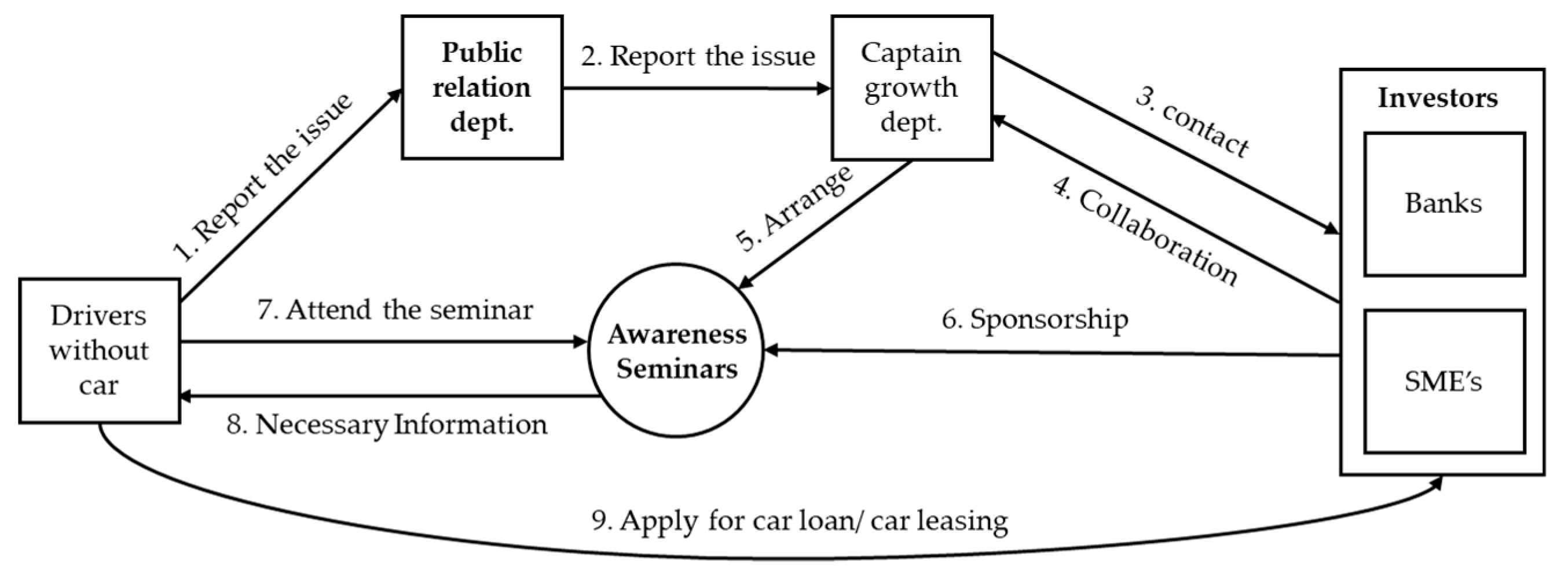
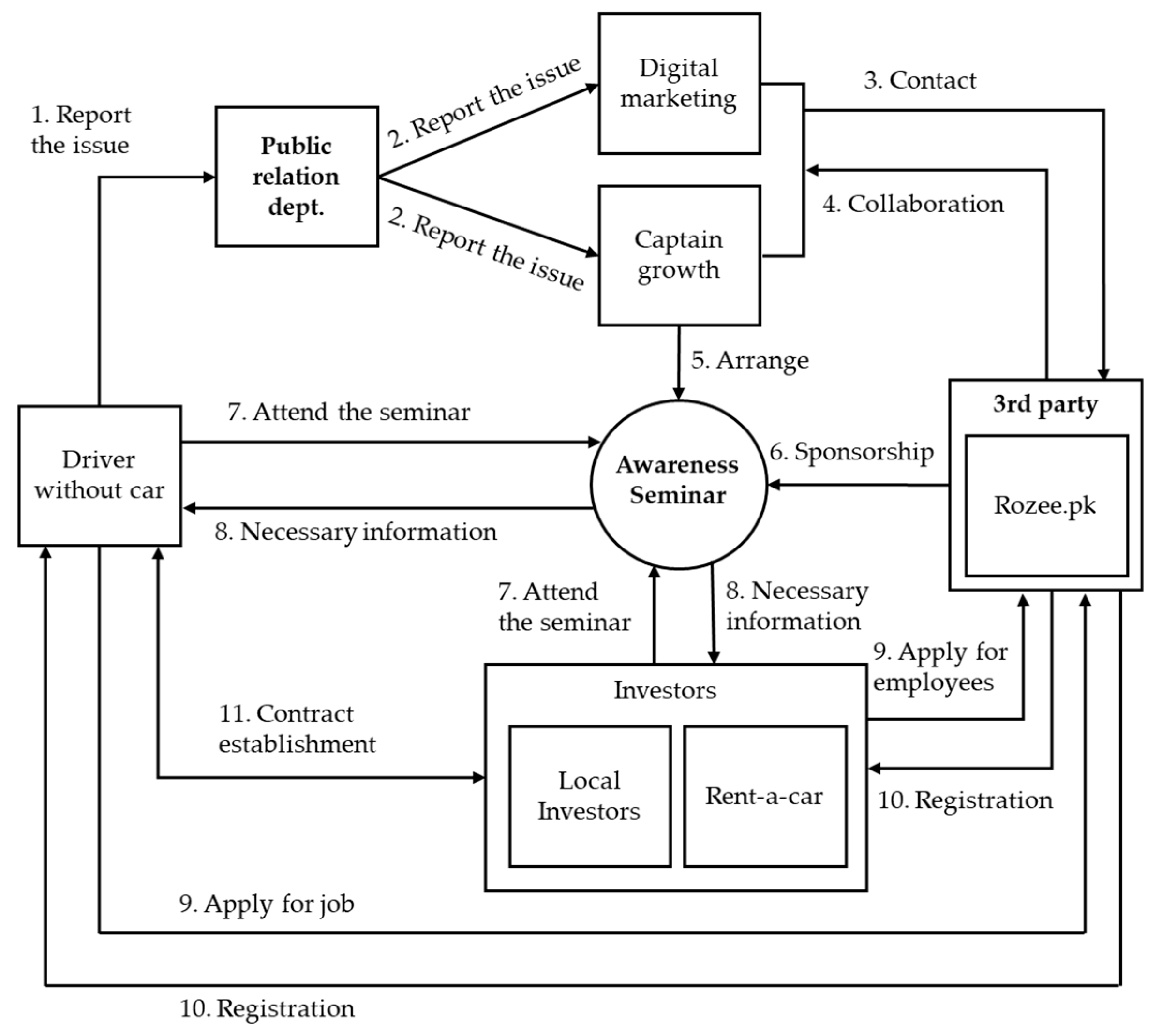
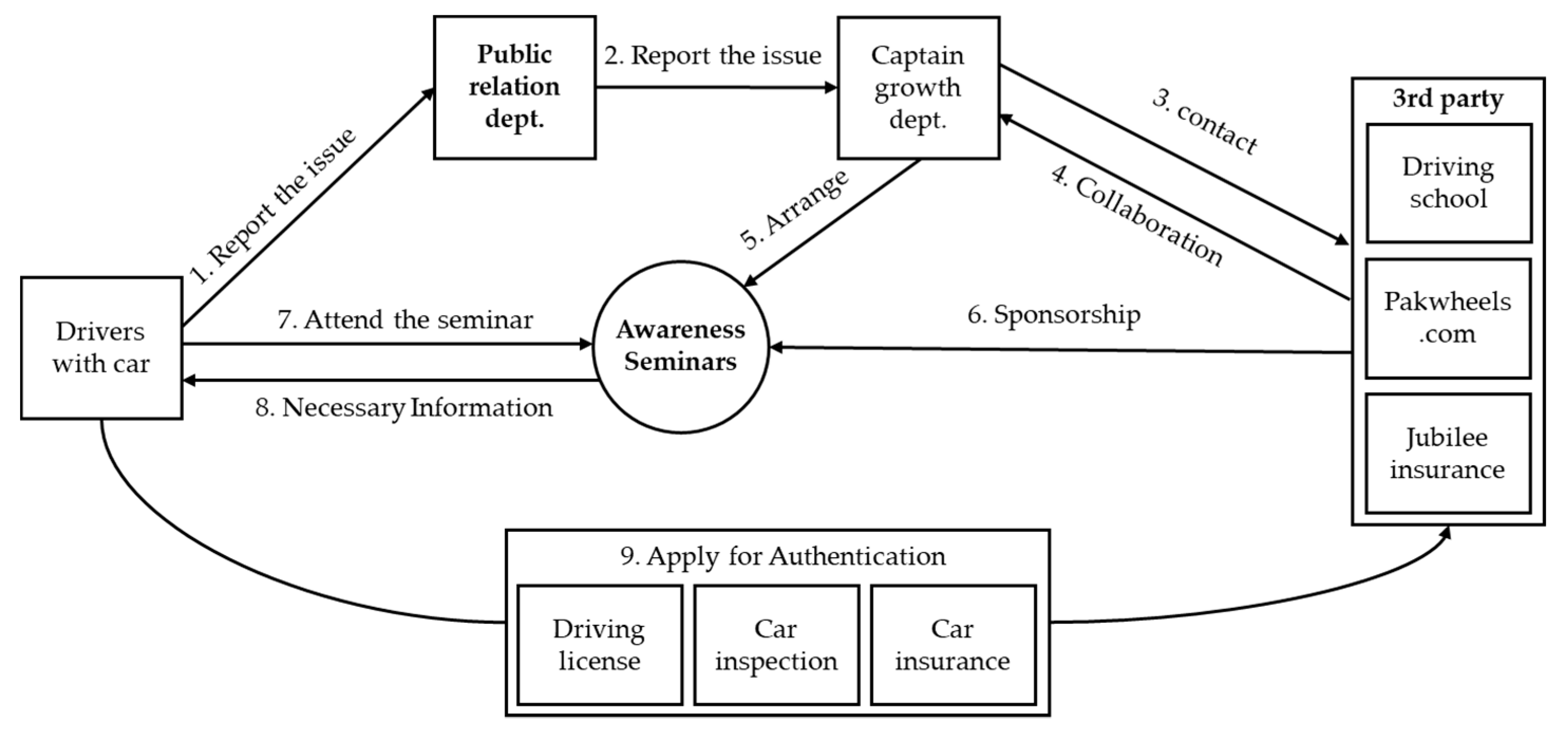
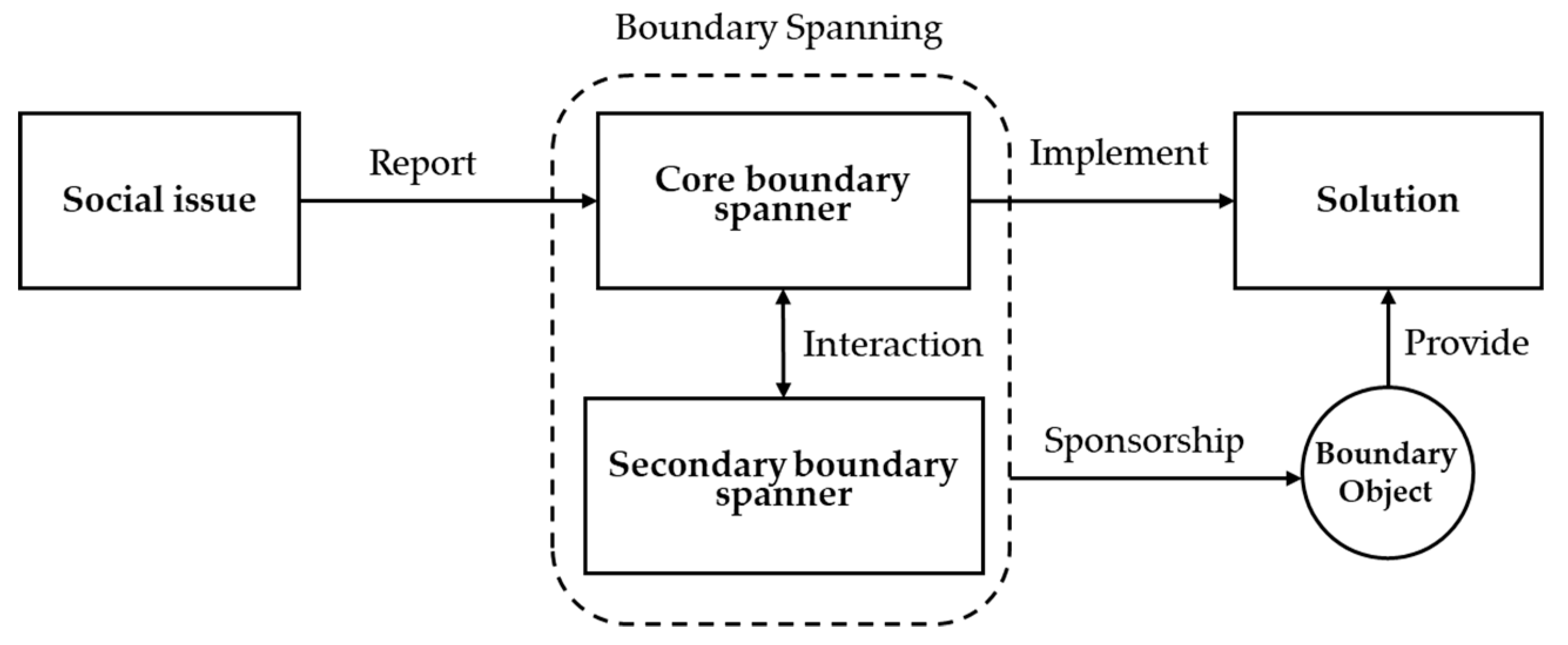

| No. | Category | Uber | Careem |
|---|---|---|---|
| 1 | Rides offered | 4 ride services in Pakistan | 5 ride services in Pakistan |
| 2 | Order a ride | Booking by app only | Booking by call, website, app |
| 3 | Ride options | Ride booking only “Now” | Ride booking “Now, later, repeat” |
| 4 | Payment method | Payment with only credit/debit card | Payment with cash, credit/debit card, and Careem wallet |
| 5 | Target group | Limited target group of customers (Middle class and rich) | Expanded target group of customers (Poor, middle class and rich) |
| 6 | Coverage area | Launched in 8+ big cities | Launched in 15+ small and big cities |
| 7 | Ride service | Profit based ride-hailing service | Social ride-hailing service (Profit + resolve social issues) |
| 8 | Market orientation | Focus on market needs | Focus on the market and social needs |
| 9 | Requirement(s) to be a driver | People who have a valid driving license and car ownership can become a driver | People who own a car or not can be a driver of Careem. But a valid driving license and supporting documentation is necessary |
| 10 | Work opportunity | Provide part-time work opportunity for the drivers | Provide part-time and full-time job opportunity for the drivers |
| 11 | Driver support | - | Careem supports its drivers to get easy loans and cars on leasing |
| 12 | Investors | Global investors | Global, local investors |
| 13 | Collaboration | - | Collaborate with 3rd parties to support drivers |
| 14 | Female driver | - | Promote female driver |
| Author | Definition of Service System |
|---|---|
| Maglio and Spohrer [29] | Service systems are compositions of value co-creation which consist of technology, people and value propositions. Service systems connect both internal and external service systems and information that is shared (e.g., methods, language). |
| Vargo, Maglio, and Akaka [30] | A service system consists of various resources (e.g., technology, people). These resources are linked with other service systems by value propositions. |
| Polese, Russo, and Carrubbo [31] | Service systems are real networks where different entities use common strengths by being directly and indirectly connected. Service systems focus on competitiveness and interaction with other service systems that are external and independent. |
| No. | Interviewees | Number of Interviews | Designation of Interviewees | Interview Duration (Minutes) | Expected Results |
|---|---|---|---|---|---|
| 1 | Careem management | 3 | Operation manager Public relation officer Strategy planning officer | 90 60 45 | Expanded business model than other TNCs |
| 2 | External investors | 3 | Local investors Bank Rent-a-car | 45 60 50 | Careem provides better and sustainable investment target |
| 3 | 3rd party | 3 | Rozee.pk Pakwheels.com Jubilee Insurance | 60 60 45 | Sustainable cross-business collaborations |
| 4 | Regulatory authority | 2 | Local police Traffic police | 30 45 | Safety measures and cross-verification of documents in Careem |
| 5 | Careem drivers | 3 | Part-time Full-time Full-time | 40 45 35 | A supportive platform for driver’s growth |
© 2019 by the authors. Licensee MDPI, Basel, Switzerland. This article is an open access article distributed under the terms and conditions of the Creative Commons Attribution (CC BY) license (http://creativecommons.org/licenses/by/4.0/).
Share and Cite
Javaid, A.; Javed, A.; Kohda, Y. Exploring the Role of Boundary Spanning towards Service Ecosystem Expansion: A Case of Careem in Pakistan. Sustainability 2019, 11, 3996. https://doi.org/10.3390/su11153996
Javaid A, Javed A, Kohda Y. Exploring the Role of Boundary Spanning towards Service Ecosystem Expansion: A Case of Careem in Pakistan. Sustainability. 2019; 11(15):3996. https://doi.org/10.3390/su11153996
Chicago/Turabian StyleJavaid, Ahson, Amna Javed, and Youji Kohda. 2019. "Exploring the Role of Boundary Spanning towards Service Ecosystem Expansion: A Case of Careem in Pakistan" Sustainability 11, no. 15: 3996. https://doi.org/10.3390/su11153996
APA StyleJavaid, A., Javed, A., & Kohda, Y. (2019). Exploring the Role of Boundary Spanning towards Service Ecosystem Expansion: A Case of Careem in Pakistan. Sustainability, 11(15), 3996. https://doi.org/10.3390/su11153996





